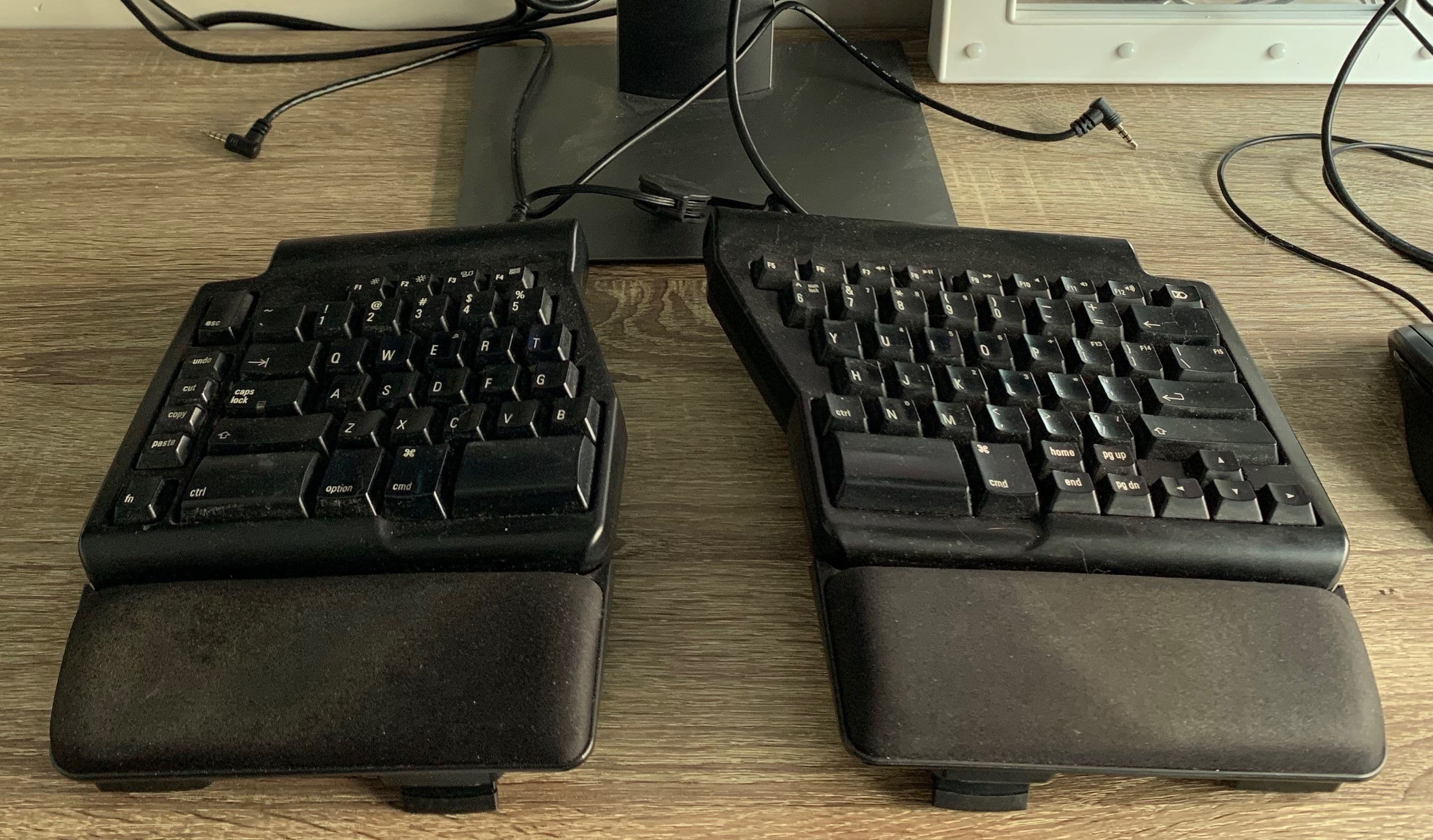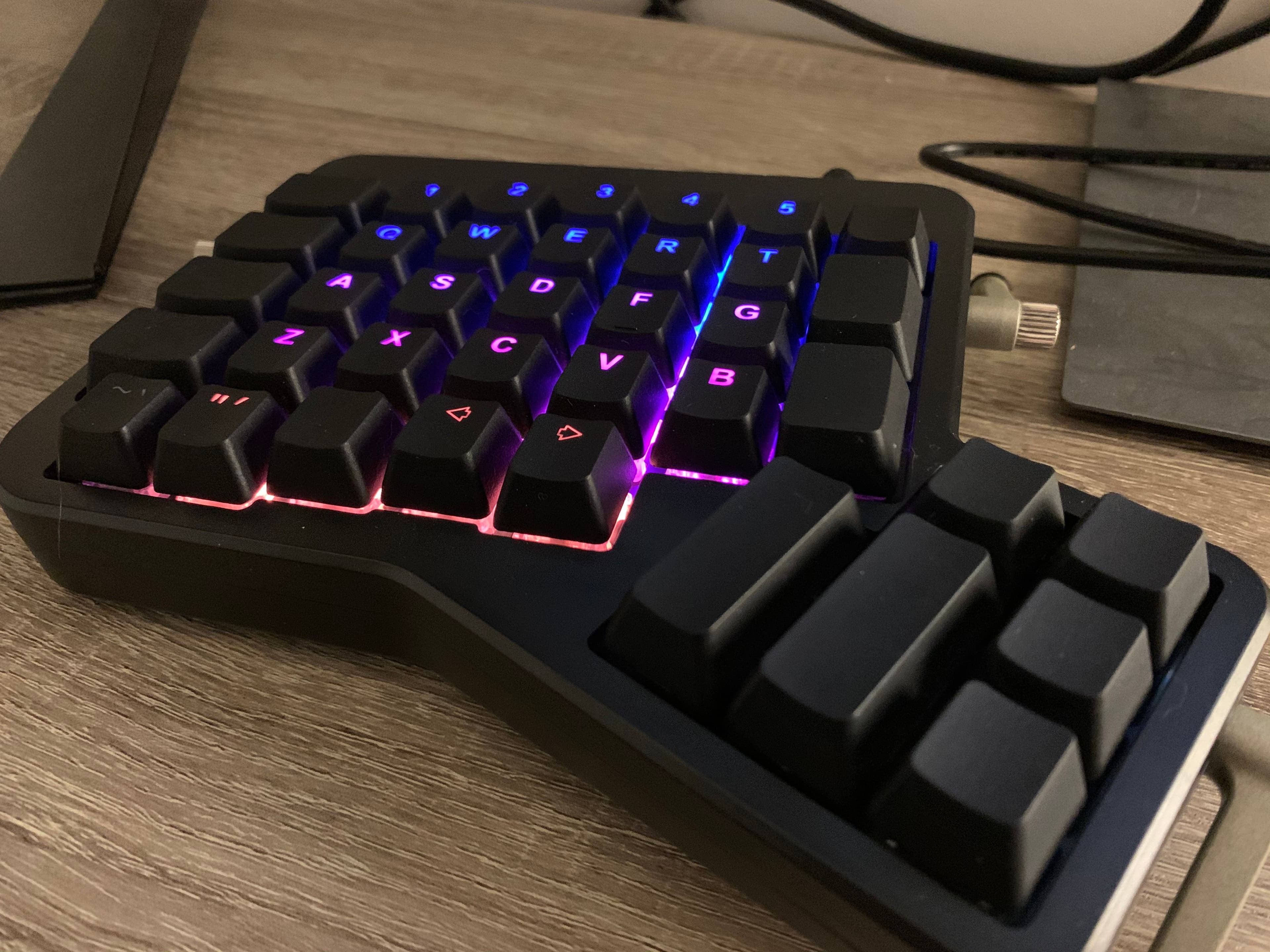Switching to Ergodox EZ
A series of posts detailing my reasoning and experiences switching to the ergodox keyboard
Posted in Personal on
Working as a programmer means being conscious on your ergonomics. After trying out a coworkers split keyboard a few years back I switched from using Apple keyboards to a Matias Quiet Pro. I went into it fully expecting it would cost me a few weeks getting used to a split layout. In reality all it took me was a few days.

Now, for the most part I really enjoyed using the Matias board. It has the most comfortable palm cushion I ever experienced and the layout worked great for me. It supports tenting and negative tilt, which I used extensively. Maybe I didn't use the split as well as I should. I often found myself slowly sliding my two keyboard halves closer to eachother during stressful moments, relying on years of muscle memory to have a higher accuracy and words per minute score. Not great for your posture, but with tenting it felt already so much better than using a "normal" keyboard.
It's also a mechanical keyboard using their own custom switches, the Matias Quiet Clicks. And it's these switches that made me look into a replacement keyboard. They slowly started misbehaving, resulting in either unregistered keypresses, double keypresses and the last couple of weeks even triple keypresses. That became infuriating.
To make matters worse, three of my colleagues experienced similar issues with their Matias boards. After running some searches on the internet it became clear we weren't the only ones facing these issues. It's clear to me the Matias boards have quality control issues. After discarding a total of four expensive keyboards we decided to ditch Matias and look into alternatives.
A shame really, as I really enjoyed my Matias board otherwise.
Searching for alternatives
When it comes to good mechanical, split keyboards there's not a lot of choice. My co-workers all switched to Kinesis Freestyle keyboards, providing a similar layout as the Matias. Some of them are gamer RGB versions with Cherry MX Reds, and others the Pro model without RGB lighting but with Cherry MX Browns. When I tried them out I discovered several things.
- Layers are confusing, but pretty powerful
- The Cherry MX Reds are not for me, but the MX Browns OK
- I really enjoy RGB lights in a keyboard. It adds a bit of flair. It's fun!
- The layout was different enough to cause me to make typos all the time.
I figured if I have to get used to a new layout anyway I could also try something more drastic. Say... a fully programmable ortholinear keyboard with thumb clusters?
The ErgoDox
The ErgoDox is an ortholinear, programmable, open-source keyboard with thumb clusters. Here's a picture of the full set.

Ortholinear means the keys are not staggered but directly on top of each other. The idea is that your fingers are roughly linear, so your keyboards keys should be too. Apparantly the only reason keyboards are staggered is because that was the only way to fit the electronic circuits in typewriters. Its an inherited design that got never questioned again.
Thanks to it's QMK firmware it's fully programmable. You can remap keys, add macros, edit layers and more. Because of the design of the ErgoDox this is not a bonus. It's a neccisity because you have less keys than on a traditional keyboard. For example there are no dedicated function keys, navigation cluster or media controls. You have to use layers to access those keys. In a way you have to bring the keys to your fingers, instead of bringing your fingers to the keys. More on this later.
Being open-source means the designs and firmware are free to use. However, you still need to source all the parts together and solder your switches to the board before you can use it. I decided to go for the easy way and purchased a built-to-order ErgoDox EZ.
The thumb clusters are designed on one important concept. Your thumbs are your strongest fingers, so why would you only use them for your spacebar? Each thumb gets a cluster of 6 keys, configurable to do anything you want, but by default the left main thumb key acts as space, while your right key serves as an enter.

Through the configurator I selected the Glow (RGB lightning) version of the ErgoDox with printed keycaps, Cherry MX browns, tilt kit and wing rests.
In part 2, I'll describe my first real experiences writing on the ErgoDox EZ.